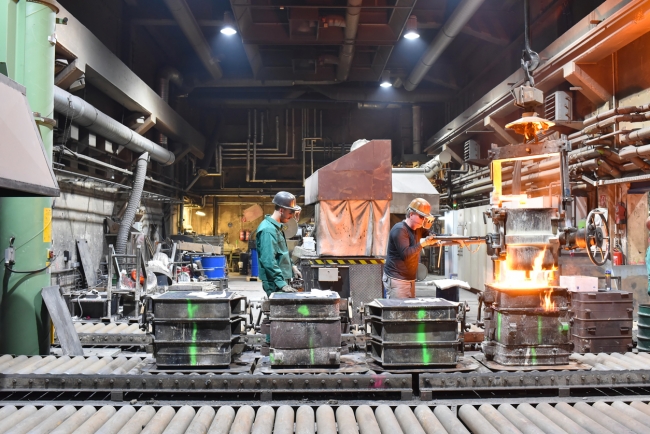5 minute read • published in partnership with PTC
Feature: How technology will help manufacturers reduce their carbon footprints and achieve sustainability goals
Climate change is fast becoming everybody’s problem, as communities worldwide increasingly bear the brunt of droughts, floods, storms, forest fires and rising seas.
The manufacturing and production sector has a big contribution to make in tackling the threat. It’s an engine of economic growth and social development, certainly, but it’s also responsible for producing 20% of global CO2 emissions and consuming 54% of the world’s energy, according to the World Economic Forum (WEF) reports and online data.
That’s why, at its annual meeting in Davos in January 2020, the WEF launched the Carbon Reduction in Manufacturing Initiative.
The transition to a net-zero industry presents a huge, untapped opportunity for manufacturing leaders to increase innovation for “growth, competitiveness and resilience”, says the initiative’s leader, Beatriz Fernandez. With that in mind, the initiative brings together global manufacturing leaders to share ideas and expertise on how the sector can cut its carbon emissions by 50% by 2030.

The manufacturing and production sector has a big contribution to make in tackling the climate change threat / Picture: Getty/iStock
One year on, the initiative is going well, Fernandez reports, despite the restrictions imposed by the Covid-19 pandemic. “In 2020, we issued a strong call to action to companies involved in advanced manufacturing and many have responded positively to that call. The Carbon Reduction Initiative will produce a publications report that will present key outcomes of this work on how to accelerate the decarbonization of the industry, which will be presented at the World Economic Forum’s Annual Meeting 2021,” she says.
“As a sector, there’s a general acknowledgement that we have a big target to reach, but there are also a great many companies out there already driving positive change and achieving great successes in reducing their environmental impact. The Carbon Reduction in Manufacturing Initiative is a global coalition of these companies, as well as companies that want to follow the example they’re setting and companies that can provide the technologies they need to achieve their goals.”
Product design and the carbon footprint
PTC is one of these companies, alongside other organisations including. The software company’s products help manufacturers design, build and connect products and factories, as well as service them in the field.
In recent years, PTC has seen a growing volume of enquiries from customers and prospects that focus specifically on how the company’s technologies might help them reduce their carbon footprints and achieve their sustainability goals, says Paul Haimes, European vice president of technical sales at the company.
What many of these manufacturing organisations are quickly realising, he says, is that the ‘greening’ of production processes, through the implementation of smart factory technologies, is an important and beneficial step – for example reducing scrap and rework reduces energy consumption – or taking production equipment offline for servicing only when it needs it – just in time as opposed to just in case. But this is only part of the picture, more focus is needed on the products themselves, and from the earliest stages of their creation.
“A great deal of the carbon debt that a manufacturer builds up in their product is as a result of decisions made in the R&D and product development departments; for example, the materials used to make the product and the processes deployed to build it,” he explains.
“Engineers in those departments are actively, and often unknowingly, committing carbon through these decisions, and the choices they make will influence the product’s lifetime carbon footprint.”

The ‘greening’ of production processes, through the implementation of smart factory technologies, is an important step to reducing carbon footprints / Picture: Getty/iStock
So what PTC is doing in response to customer interest and questions, he says, is figuring out how to put technology tools in the hands of manufacturers to enable them to make more informed decisions, earlier on. For example, that may mean expanding the capabilities of product lifecycle management (PLM) technology, which already handles all the information relating to a product, its constituent parts and its service requirements throughout its lifetime. In other words, that means extending PLM’s reach further, to include more data on the sustainability implications of products, parts and services.
And generative design technology, which relies on computer algorithms to explore potential variants of a design, is opening up new ways to lightweight parts, consolidate assemblies and investigate different materials. These algorithms must first be fed specific constraints that their proposed designs must meet. For that reason, says Haimes, it makes sense to include future carbon debt as a design constraint.
At the same time, says Haimes, PTC is looking beyond the product design phase, at the wider concept of the ‘circular economy’ – the idea of finally putting to bed the ‘take-make-waste’ approach to manufacturing, in favour of designing out waste and pollution at every stage of a product’s lifecycle.
Here, he says, smarter approaches to servicing connected products, which use sensors to report back to the manufacturer on their status, use and condition, will help extend their lifetime, through approaches such as predictive maintenance. Servicing based on augmented reality, meanwhile, “can ensure that the right fixes are provided, quickly and cost-efficiently, at just the right time, before an issue becomes a problem.”
Finally, says Haimes, PLM also has an important role to play in end-of-life processes, ensuring that a redundant product’s components and materials are handled appropriately and reused wherever possible.
Weighing up decarbonisation approaches
Weighing up how and where new technologies should be used is an extremely important aspect of the Carbon Reduction in Manufacturing Initiative’s work, agrees Fernandez.
“Every company in this space needs to understand not only what core innovations or actionable technology solutions are available, but also how they might best be applied to their own business, in really practical ways, to drive fast and meaningful progress in sustainability terms,” she says. “As a result, a big focus for us is to facilitate an exchange of knowledge and expertise around successful use cases.”
For that reason, the next big milestone for the Initiative is to present some of those leading use cases at the WEF’s Special Annual Meeting, scheduled to take place in Singapore in May 2021.
“By highlighting these successful use cases, we hope to foster a conversation around what is working well, and how we can escalate and amplify those efforts. At the same time, we also want to do more work and have more conversations that help to identify what areas of sustainable manufacturing are not yet well-addressed by technology innovations,” she says.
“I believe these conversations will set the stage for the next evolution of this initiative and help us, as a global community of manufacturer leaders, to accelerate even further our transition to a net-zero industry.”